Winter’s got your garden looking like a zombie apocalypse? Fear not! These 17 hardy heroes defy the freeze, bursting with color when the world turns gray.
Plant them now and watch your yard become the envy of the neighborhood—because who says winter has to be boring? Let’s dive into these frost-fighting wonders that’ll keep you scrolling for more garden magic.
1. English Primrose
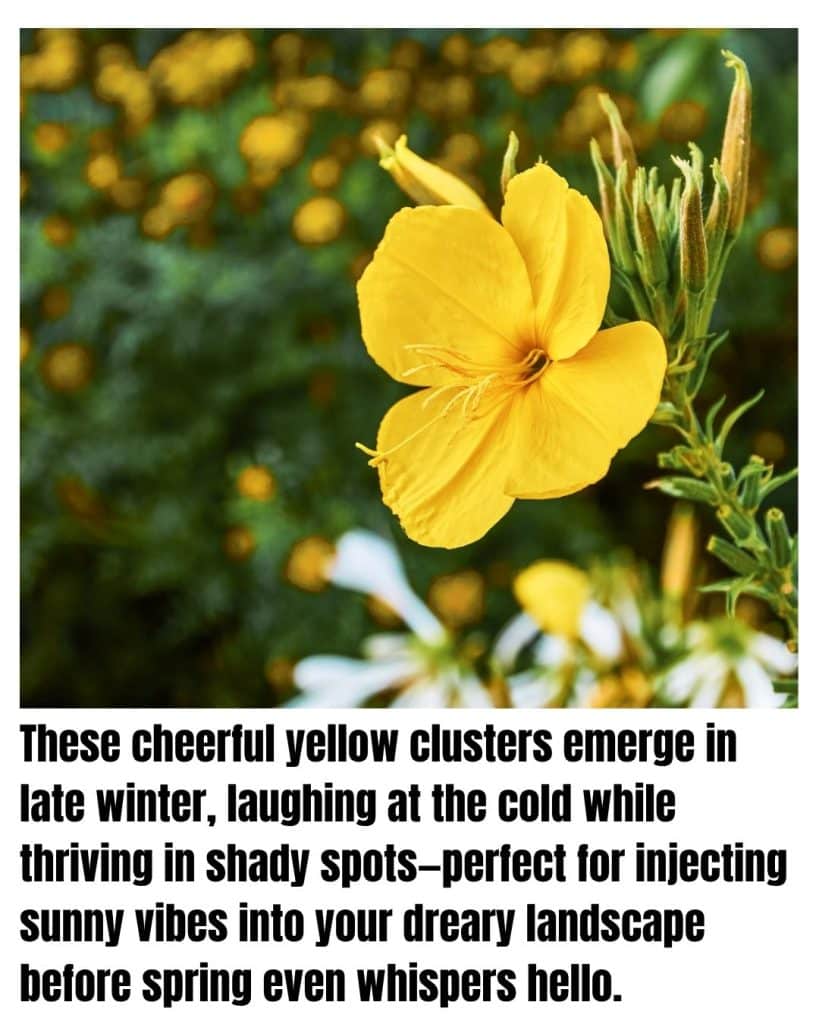
- Blooms Galore: These pint-sized powerhouses are like nature’s confetti, with blooms in every color imaginable, including rare blues, making them a gardener’s secret weapon for instant cheer.
- Did you know?: They’re edible! Toss the flowers into salads for a peppery kick, but skip the leaves unless you want a tummy tango.
- Where It Grows: Thrives in USDA zones 3-8, loving moist, shady spots across the US, from New England’s forests to Pacific Northwest gardens.
Don’t let winter’s icy grip fool you—the English Primrose laughs in its face, popping up vibrant blooms as early as late winter through early spring, sometimes even peeking through snow.
These hardy perennials self-seed like pros, turning your garden into a colorful carpet without much effort. Plant them in partial shade with rich, well-drained soil, and watch them multiply.
In milder southern zones, they might bloom sporadically year-round, but their peak show is February to April, adding pops of yellow, pink, or purple when your yard needs it most. Pair with bulbs for a layered spectacle that’ll have neighbors green with envy.
2. Winter Jasmine
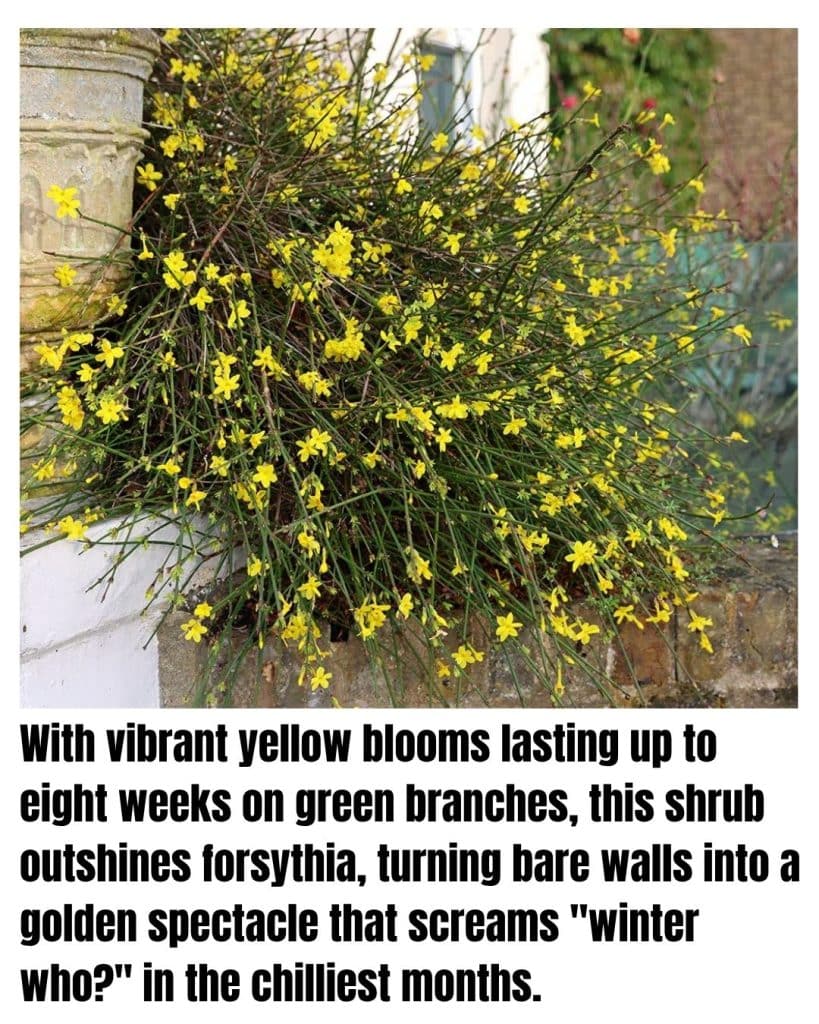
- Bare and Just Don’t Care: Unlike spring bloomers, this vine flowers on bare stems, creating a golden waterfall effect that cascades over walls or trellises for dramatic winter drama.
- Imposter Syndrome: It’s not a true jasmine—more like a sunny imposter with no fragrance, but it compensates with blooms that last up to two months in the chill.
- Where It Grows: Best in USDA zones 6-10, from the Southeast to California, where it clings to sunny spots and tolerates urban pollution like a champ.
Winter Jasmine is your garden’s rebellious streak, bursting into bright yellow stars from December to March, defying the frost while everything else hibernates.
This vigorous climber can reach 15 feet, perfect for training over arbors or fences to create a living sunshine barrier. In northern US areas, it might need mulch for protection, but in milder climates like the South, it blooms reliably through winter.
Non-invasive and deer-resistant, it thrives in full sun with average soil, attracting early pollinators. Prune after flowering to keep it tidy—imagine your barren yard transformed into a glowing haven that screams “take that, winter!”
3. Hellebore
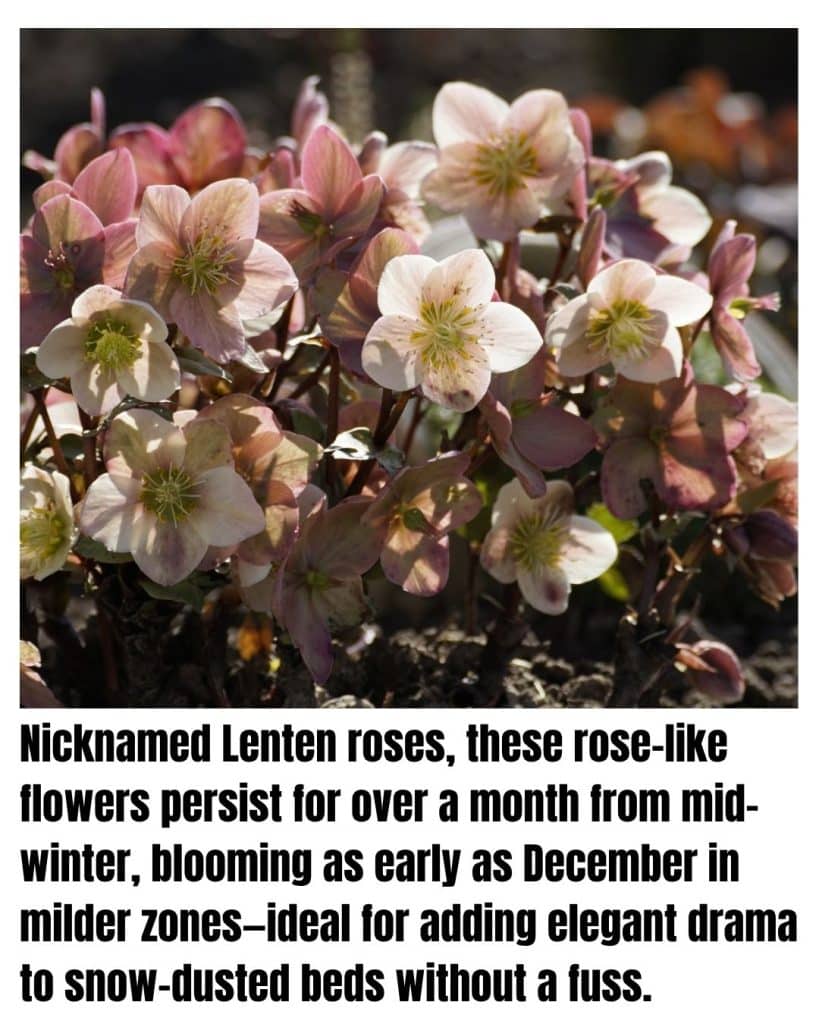
- A Rose By Any Other Name… Nicknamed “Christmas Rose,” its downward-facing blooms nod elegantly, protecting pollen from winter rains, and they change color as they age for evolving beauty.
- Poisonous but pretty—all parts are toxic, so handle with care, but they’re deer-proof, making them a fortress in critter-prone gardens.
- Where It Grows: Zones 4-9, from the Midwest to the West Coast, preferring shady, woodland-like conditions with moist, alkaline soil.
Hellebores are the unsung heroes of winter gardens, unfurling rose-like flowers from December to April, sometimes lasting into May for an extended show.
These evergreen perennials bloom in shades of white, pink, and purple, with some hybrids offering double petals for extra flair. In colder northern states, they emerge through snow, while southern gardens enjoy them as reliable shade fillers.
Plant in well-drained, humus-rich soil under trees; they’re low-maintenance once established, resisting drought and pests.
Their leathery leaves provide year-round structure—think of them as your garden’s tough cookies, delivering color and intrigue when the world turns monochrome.
4. Winter Aconite
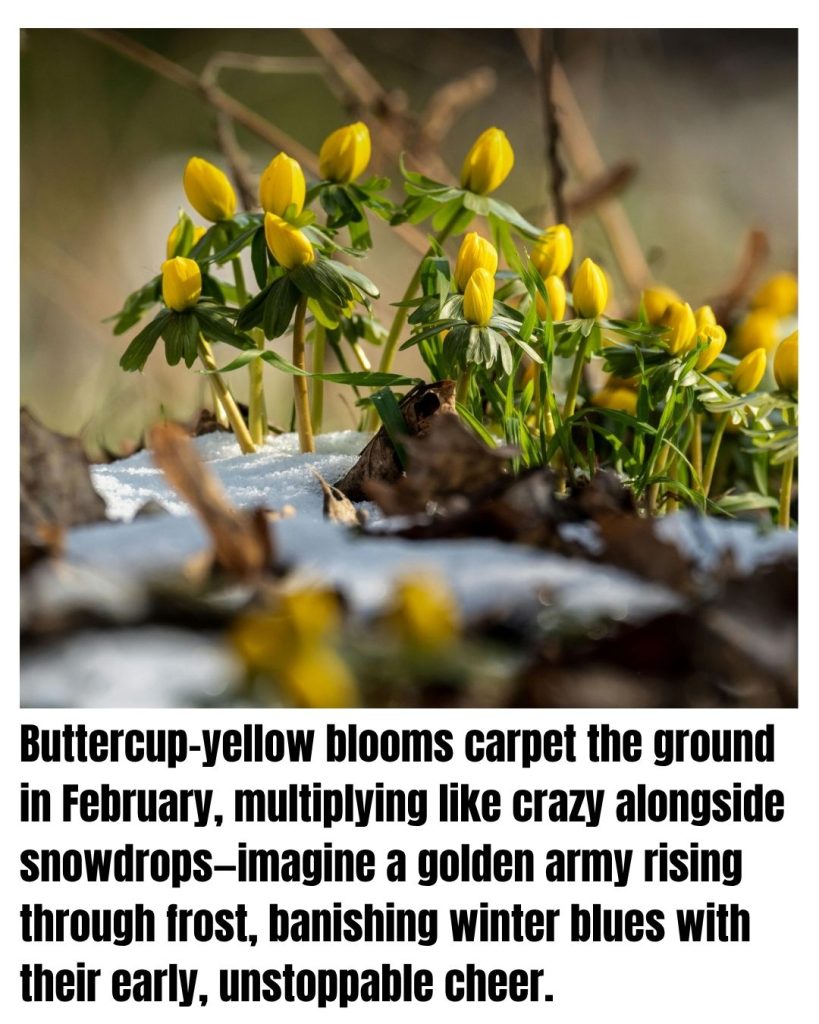
- Special Trait: These buttery blooms open wide on sunny days and close at night, like tiny solar panels soaking up winter light for maximum cheer.
- Interesting Fact: Related to buttercups, they contain natural antifreeze, allowing them to push through frozen ground and carpet areas with golden joy.
- Where It Grows: USDA zones 3-7, ideal for northern and midwestern US, in woodlands or lawns where they naturalize quickly in moist, shady spots.
Winter Aconite is the ultimate early bird, carpeting the ground with sunny yellow cups from late January to March, beating most spring flowers to the punch.
These bulbous perennials multiply underground, forming dense mats that brighten barren lawns or under trees.
In harsh winters across the Northeast, they poke through snow like defiant rebels; milder zones see them bloom even earlier.
Plant bulbs in fall in well-drained soil with partial shade—they’re toxic to pets but irresistible to bees. Low-growing at just 4 inches, they’re perfect for naturalizing, turning your frosty yard into a golden wonderland that hints at spring’s arrival with infectious optimism.
5. Camellia

- Doesn’t Care About the Snow: With waxy, evergreen leaves and blooms resembling lush roses, they provide year-round structure, plus some varieties drop petals like confetti for a romantic cleanup.
- Tea leaves come from a cousin—Camellia sinensis—but these ornamental types are all about show, with flowers that can span up to 5 inches wide.
- Where It Grows: Climate Zones 6-9, thriving in the humid Southeast and Pacific Northwest, in acidic, well-drained soil with morning sun and afternoon shade.
Camellias turn winter into a floral fiesta, with plump blooms in pinks, reds, and whites from October to April, peaking mid-winter in milder climates.
These shrubs can live over 100 years, growing into small trees up to 20 feet tall for timeless elegance. In southern US gardens, they’re staples for hedges or specimens; northern edges require cold-hardy varieties like ‘Winter’s Star’ to withstand freezes.
Plant in sheltered spots with mulch to protect roots—they love acidic soil amended with pine needles. Attracting birds and butterflies, they add fragrance and flair, making your yard a blooming oasis amid the chill.
6. Crocus

- Closing Time: These goblet-shaped blooms open during the day and close at night, acting like natural barometers that predict sunny weather for your winter garden.
- Ancient saffron source—the spice comes from Crocus sativus stigmas, harvested by hand, making it pricier than gold by weight.
- Where It Grows: USDA zones 3-8, from Rocky Mountains to East Coast, in sunny lawns or borders with well-drained soil where they naturalize wildly.
Crocus heralds the end of winter with a burst of purple, yellow, and white cups from February to April, often pushing through lingering snow for a triumphant show.
These corms multiply underground, creating colorful colonies that light up dormant lawns like buried treasure unearthed. In northern US climes, they’re among the first to bloom, while southern gardens enjoy extended displays.
Plant in fall in full sun; they’re deer-resistant but bee magnets. Mix varieties for a sequential bloom parade—your yard becomes a vibrant mosaic, teasing spring’s arrival with cheeky charm and effortless spread.
7. Japanese Pieris

- Clusters That Don’t Die: Drooping clusters resemble lily-of-the-valley, but with colorful new foliage in reds and bronzes that steal the show after flowers fade.
- Toxic to pets and people—contains grayanotoxins, so admire from afar, but it’s a pollinator paradise for early bees.
- Where It Grows: USDA zones 5-8, thriving in the Northeast and Pacific Northwest, in acidic, moist soil under partial shade like rhododendron companions.
Japanese Pieris defies winter doldrums with pendulous white or pink bells from late winter into spring, blooming from February to May for a prolonged spectacle.
This evergreen shrub grows 3-6 feet, offering year-round structure with glossy leaves that turn fiery in new growth. In cooler US regions, it withstands snow; warmer areas see it as a shade-tolerant staple.
Plant near foundations or in woodland gardens—acid-loving, it pairs perfectly with azaleas. Deer might nibble, but its nectar draws hummingbirds, transforming your landscape into a buzzing, blooming haven that bridges seasons with elegant flair.
8. Reticulated Iris
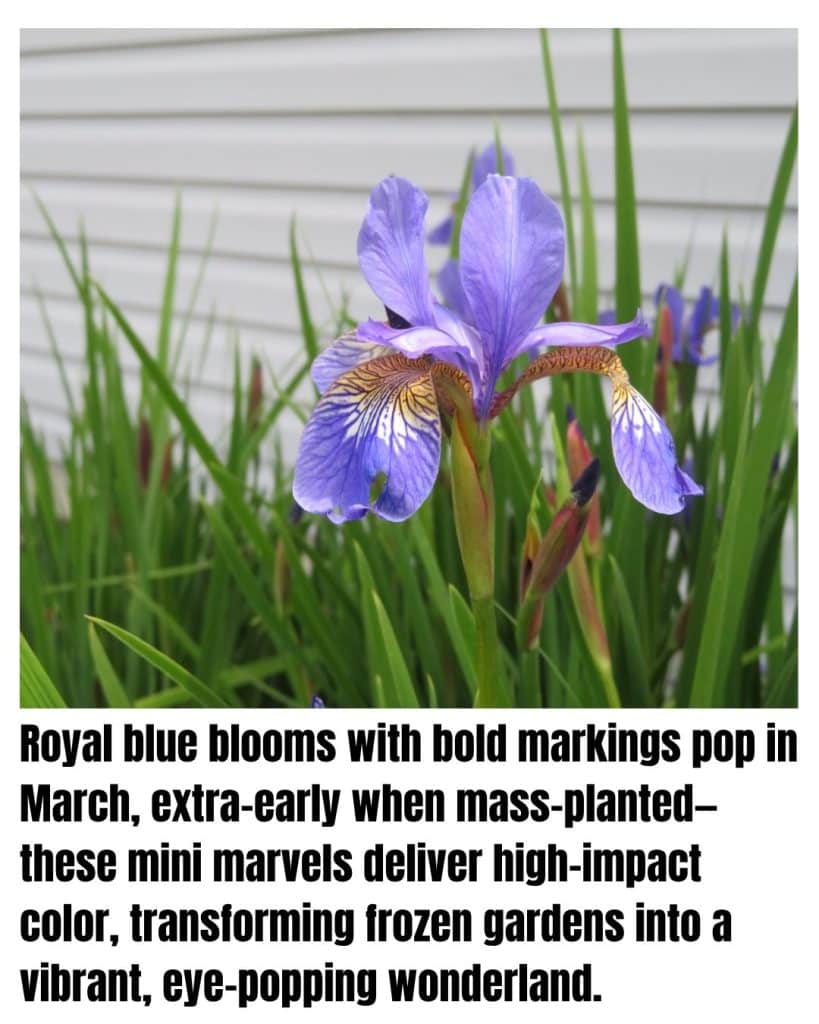
- Intricate veining on petals gives a netted look, like exotic jewels, with blooms that last longer in cool weather for extended admiration.
- Interesting Fact: One of the smallest irises at just 6 inches tall, yet packs a punch with fragrance reminiscent of violets or grapes.
- Where It Grows: USDA zones 5-9, from Midwest prairies to Southwest deserts, in rocky, well-drained spots with full sun exposure.
Reticulated Iris kicks off late winter with royal blue and yellow blooms from February to March, sometimes as early as January in mild zones for a precocious pop.
These dwarf bulbs naturalize rapidly, forming clumps that dazzle in rock gardens or borders without much fuss. Across the US, they thrive in dry summers post-bloom; northern gardeners mulch for winter protection.
Plant in fall in gritty soil—they’re drought-tolerant once established. Their bold markings and scent attract early insects, turning frozen patches into a miniature masterpiece that whispers of warmer days ahead with irresistible allure.
9. Winter Heath

- Tiny urn-shaped flowers cover the plant like a fuzzy blanket, providing nectar for winter-active bees in a pollinator lifeline.
- Blooms for months—from fall through spring, outlasting most, and its foliage turns bronze in cold for added seasonal interest.
- Where It Grows: USDA zones 4-7, ideal for northern states like New England, in acidic, sandy soil with full sun to partial shade.
Winter Heath blankets your garden in pink, white, or purple bells from November to April, extending into May for an epic, frost-proof display.
This low-growing evergreen spreads to 2 feet wide, perfect as groundcover that suppresses weeds while adding texture. In chilly US climates, it shrugs off snow; southern edges might see shorter blooms.
Plant in rockeries or heath gardens—acidic soil is key, with good drainage. Deer-resistant and low-maintenance, it creates a colorful mat that hums with life, banishing bare spots and injecting endless winter whimsy into your outdoor space.
10. Snowdrops
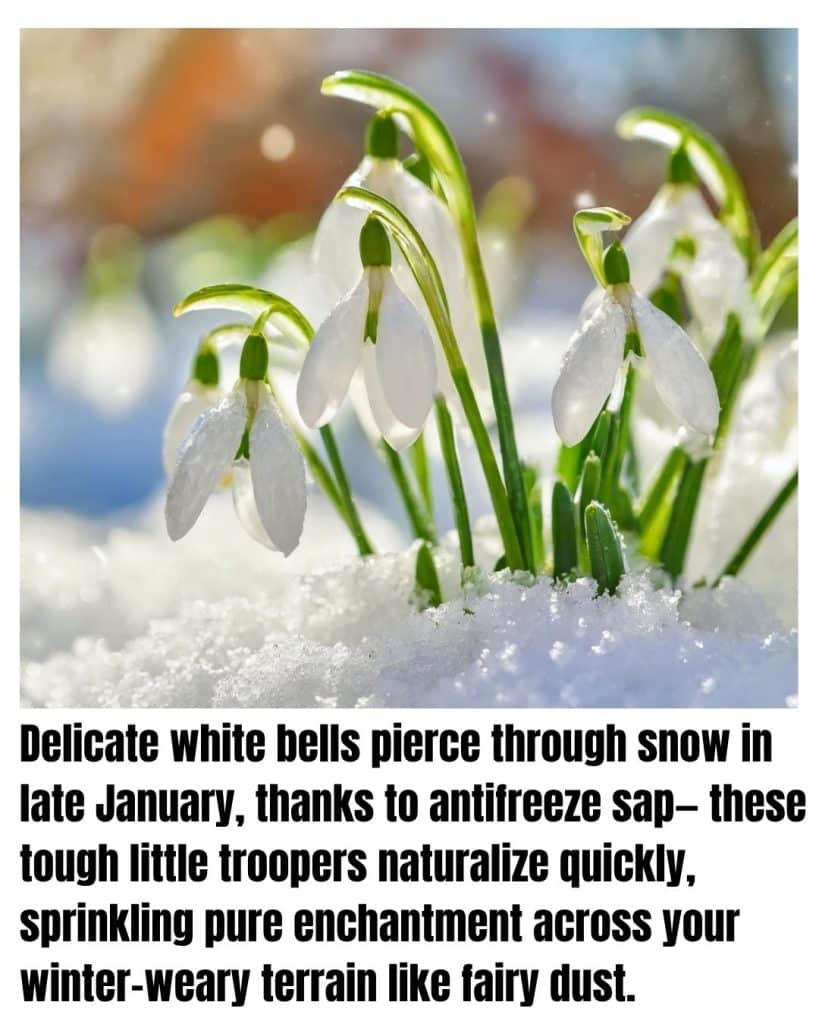
- Nodding white bells with green tips dangle like earrings, engineered to withstand snow with built-in antifreeze for resilient beauty.
- Symbolizes hope in folklore, often planted on graves, but they’re multiplying machines that double yearly for garden takeovers.
- Where It Grows: USDA zones 3-8, from Great Lakes to Appalachians, in moist, shady woodlands or under deciduous trees.
Snowdrops pierce winter’s veil with delicate white blooms from January to March, often emerging through snow for a magical, early awakening.
These bulbs naturalize effortlessly, forming drifts that brighten shaded areas with pure elegance. In northern US winters, they’re frost-hearty survivors; milder zones enjoy them sooner.
Plant in fall in humus-rich soil—they thrive under trees, going dormant in summer. Mildly fragrant and bee-friendly, they signal renewal, turning your dormant yard into an enchanted forest floor that captivates with subtle charm and promises of spring’s imminent embrace.
11. Witch Hazel
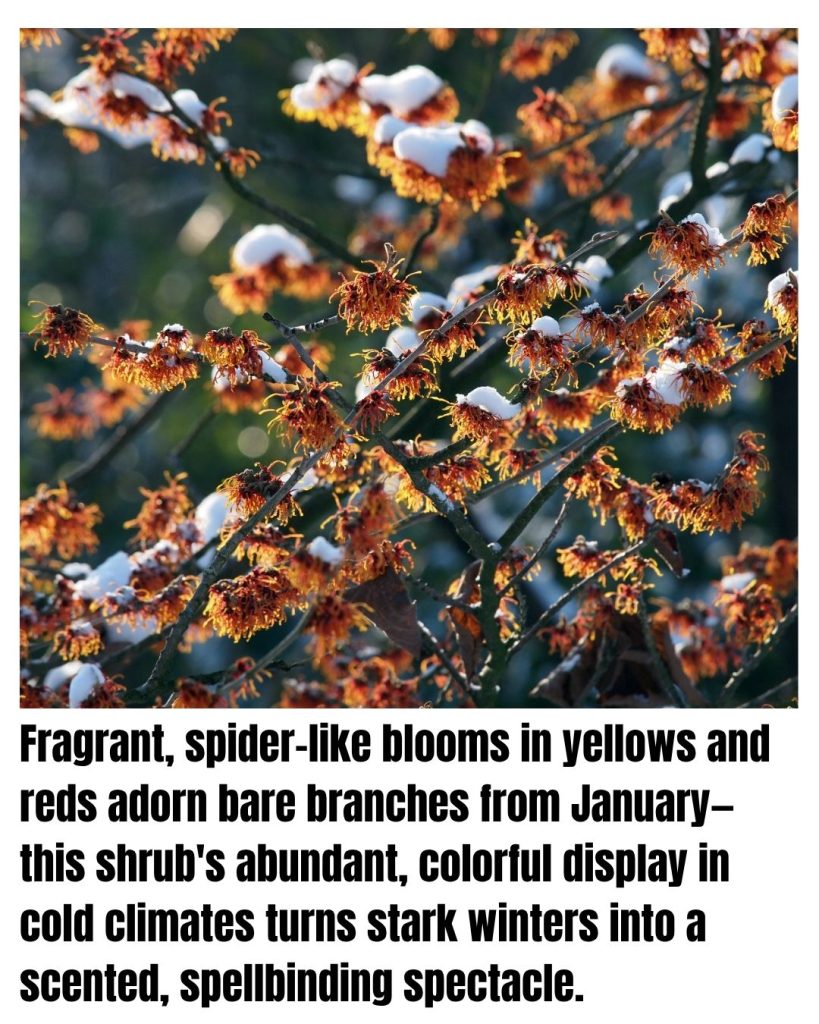
- Spider-like petals unfurl on bare branches, releasing a spicy fragrance that perfumes the winter air like nature’s potpourri.
- Blooms in freezing temps—its flowers can freeze solid at night and thaw to bloom again by day, a true cold-weather wizard.
- Where It Grows: USDA zones 5-8, from the Midwest to Southeast, in moist, well-drained woodlands or sunny edges across the US.
Witch Hazel casts a spell on barren winters with ribbon-like blooms in yellows, oranges, and reds from October to March, peaking in January for a fragrant fireworks show.
This deciduous shrub reaches 15 feet, providing fall color before its winter act steals the spotlight. In northern states, it braves snow; southern gardens enjoy extended displays.
Plant in full sun to partial shade with acidic soil—it’s low-maintenance, attracting birds with seeds. Imagine your yard alive with twisted petals dancing in the breeze, turning frosty days into an aromatic adventure that defies the chill.
12. Glory of the Snow
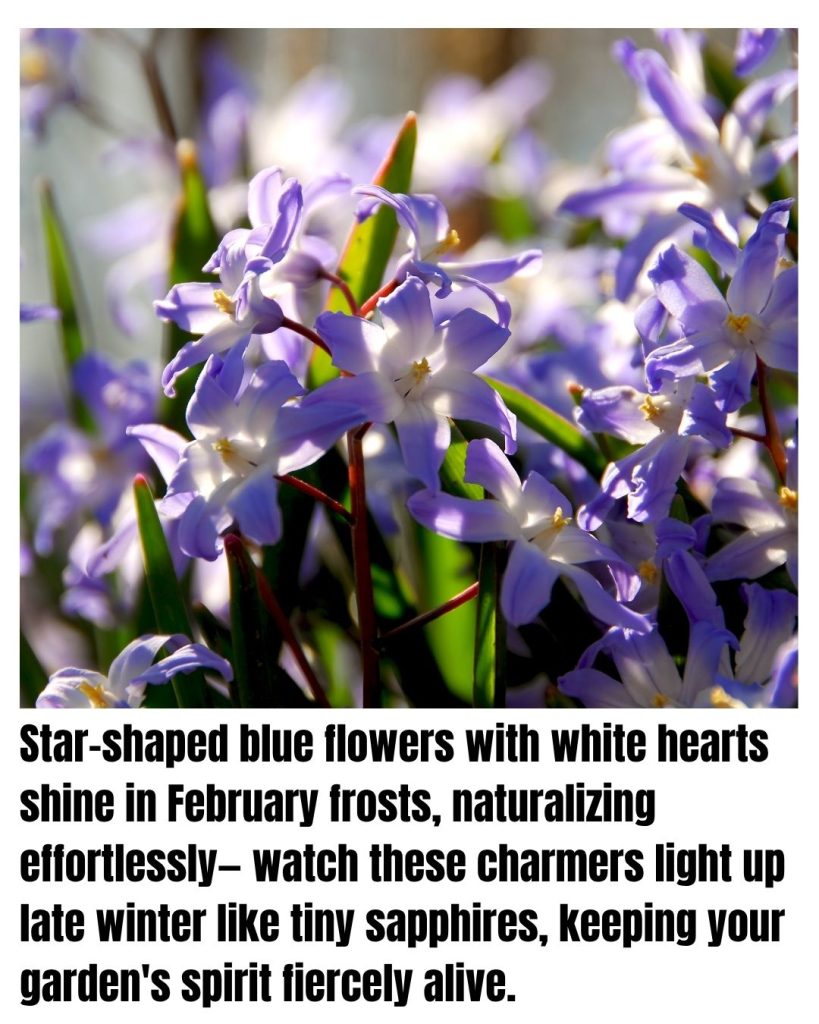
- Starry flowers with contrasting white centers open wide in sun, closing in shade like shy performers waiting for applause.
- Snow Connection: Named for blooming right after snow melts, they naturalize faster than gossip spreads, covering ground in blue waves.
- Where It Grows: USDA zones 3-8, thriving in northern and midwestern states, in well-drained lawns or borders under light shade.
Glory of the Snow lives up to its name, sprinkling sapphire-blue stars from late winter to early spring, typically February to April, often piercing through melting snow for a triumphant debut.
These bulbs multiply like rabbits, forming dense carpets that brighten dormant turf. In cold US climates like the Northeast, they’re snow-tolerant survivors; milder areas see them bloom sooner.
Plant in fall in sunny spots with average soil—they’re petite at 4 inches, perfect for edging paths. Bee-friendly and effortless, they transform your garden into a twinkling constellation, heralding spring with cheerful persistence.
13. Hardy Cyclamen

- Upswept petals resemble butterfly wings, fluttering above marbled, heart-shaped leaves for a whimsical, fairy-tale vibe.
- Dormant in summer—they vanish underground to escape heat, re-emerging in fall like seasonal nomads.
- Where It Grows: USDA zones 5-9, from East Coast woodlands to California hills, in dry shade with well-drained, gritty soil.
Hardy Cyclamen adds enchantment to winter with nodding pink or white blooms from September to March, hitting peak in January for a delicate display amid frost.
These tuberous perennials spread via ants carrying seeds, creating colonies in shaded nooks. In northern US zones, mulch protects them; southern gardens treat them as evergreen accents. Plant under trees or shrubs—they thrive in poor soil, resisting deer.
Their foliage lingers post-bloom, providing groundcover. Picture your shady spots alive with fluttering flowers, banishing winter blahs with subtle magic and easy elegance.
14. Pansy
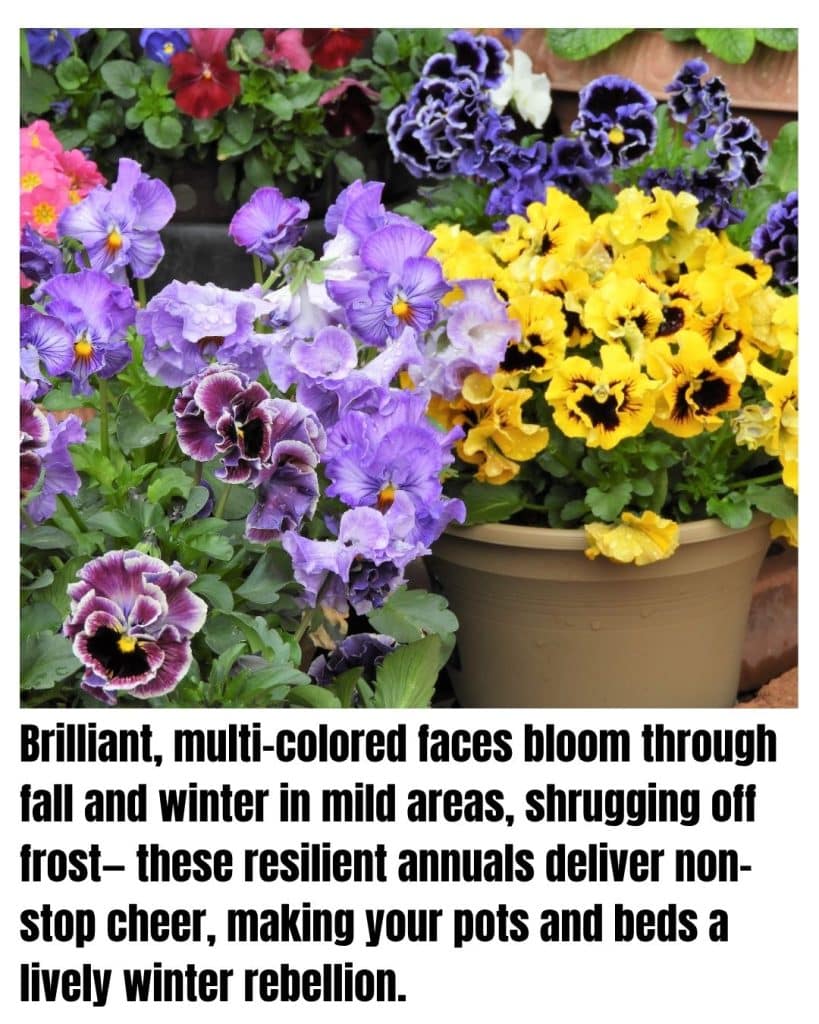
- “Faces” with bold markings come in endless color combos, including rare blacks and blues, like customizable garden emojis.
- Edible and medicinal—flowers add color to salads or soothe sore throats in teas, a tasty two-for-one.
- Where It Grows: USDA zones 4-8 as annuals, nationwide in cool-season beds or containers with rich, moist soil.
Pansies thumb their noses at frost, blooming vibrantly from fall through winter into spring, often from November to May in mild climates for non-stop color. These cool-weather annuals self-seed in spots, popping up unexpectedly like welcome surprises.
Across the US, they’re winter staples in the South, while northern gardeners use them for seasonal pops.
Plant in sun or part shade—they love fertilizer for bigger blooms. Deer might munch, but their resilience shines. Envision your pots overflowing with cheerful faces, turning chilly days into a playful palette that keeps the garden grinning.
15. Mahonia
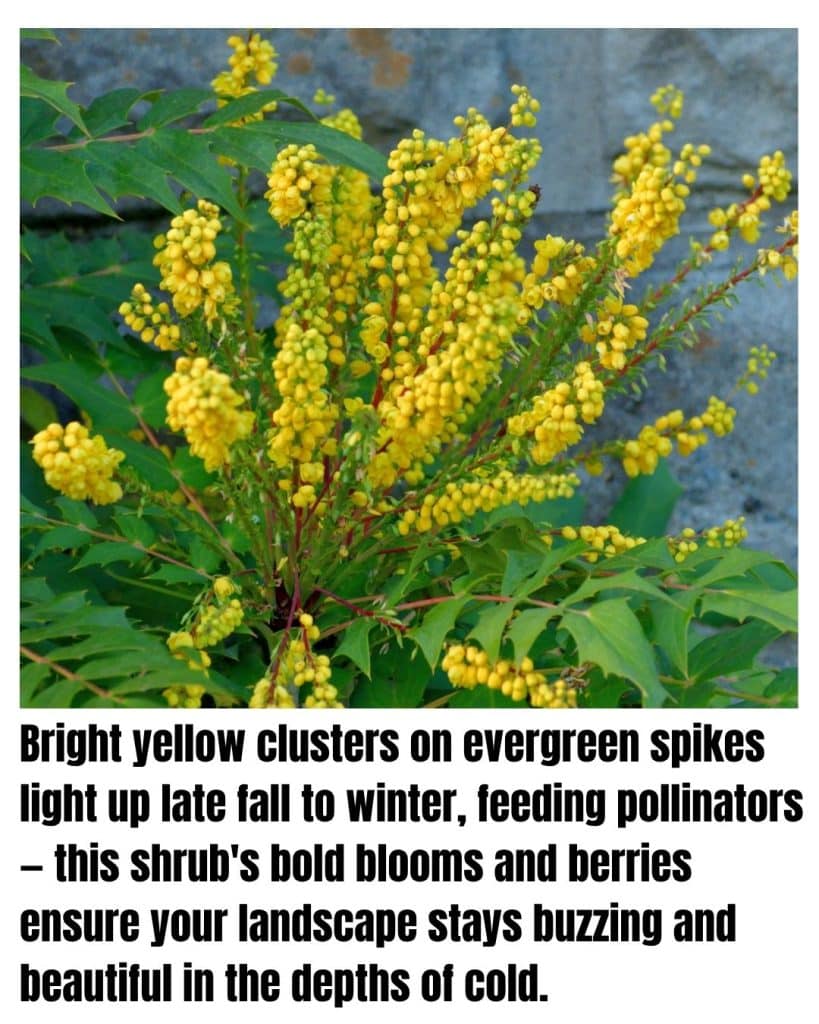
- Special Trait: Spiky, holly-like leaves frame grape-like berries post-bloom, feeding birds while adding edible (if tart) human treats.
- Interesting Fact: Evergreen armor—its prickly foliage deters deer and intruders, making it a natural garden guardian.
- Where It Grows: USDA zones 5-9, from Pacific Northwest forests to Southern plains, in partial shade with acidic, moist soil.
Mahonia lights up late fall to winter with sunny yellow spikes from November to March, followed by blue berries for extended interest.
This shrub grows 3-10 feet, depending on variety, offering year-round structure and fragrance.
In western US, it’s drought-tolerant once established; eastern gardens appreciate its shade adaptability. Plant as hedges or accents—it attracts pollinators early.
Low-care and versatile, it transforms borders into buzzing beacons, blending bold blooms with wildlife appeal to conquer winter’s gray with spiky splendor.
16. Daphne
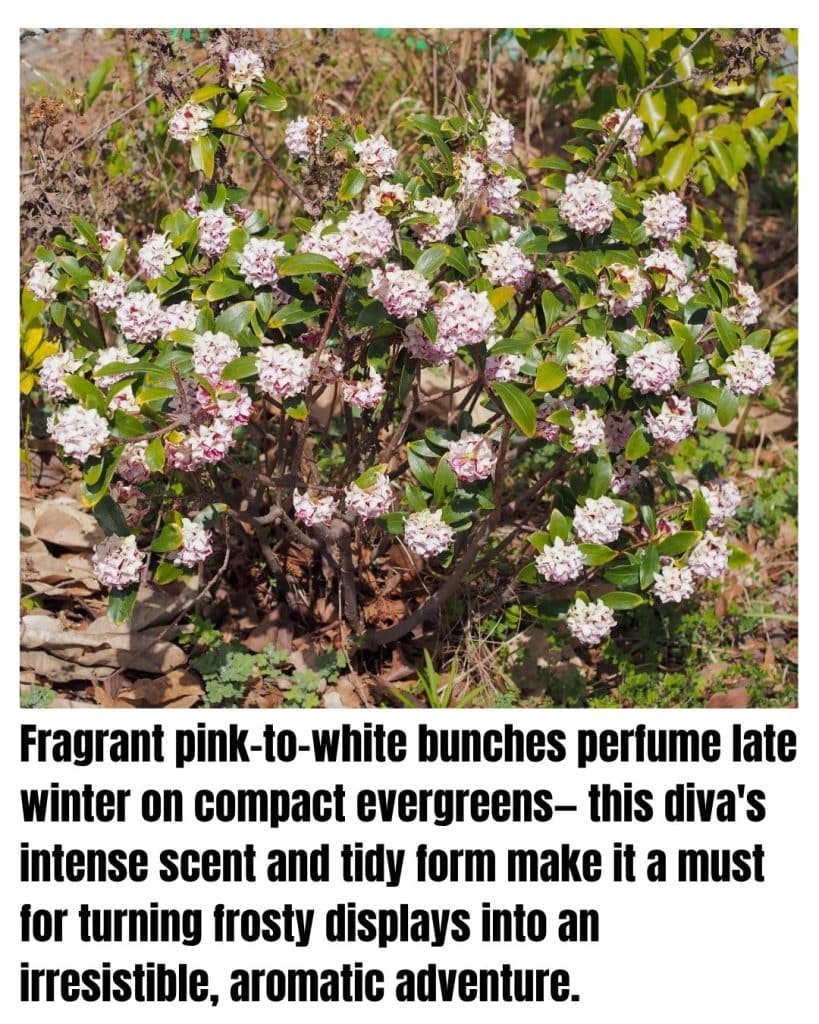
- Special Trait: Intensely fragrant clusters perfume a wide radius, like a natural air freshener that outshines synthetic scents.
- Interesting Fact: Slow-growing diva—takes years to mature but rewards with longevity, some living decades if pampered.
- Where It Grows: USDA zones 4-9, in protected spots from New England to the West Coast, in well-drained, neutral soil with morning sun.
Daphne enchants late winter with pink-to-white blooms from February to April, their heady scent wafting through the chill for an irresistible allure.
This compact evergreen stays under 4 feet, ideal for small spaces or containers. In colder US areas, site it sheltered from winds; warmer zones enjoy it as a foundation plant.
Plant in humus-rich soil—avoid overwatering to prevent root rot. Toxic but tantalizing to bees, it adds elegance and aroma, turning your garden into a scented sanctuary that beckons even in the depths of winter.
17. Sarcococca
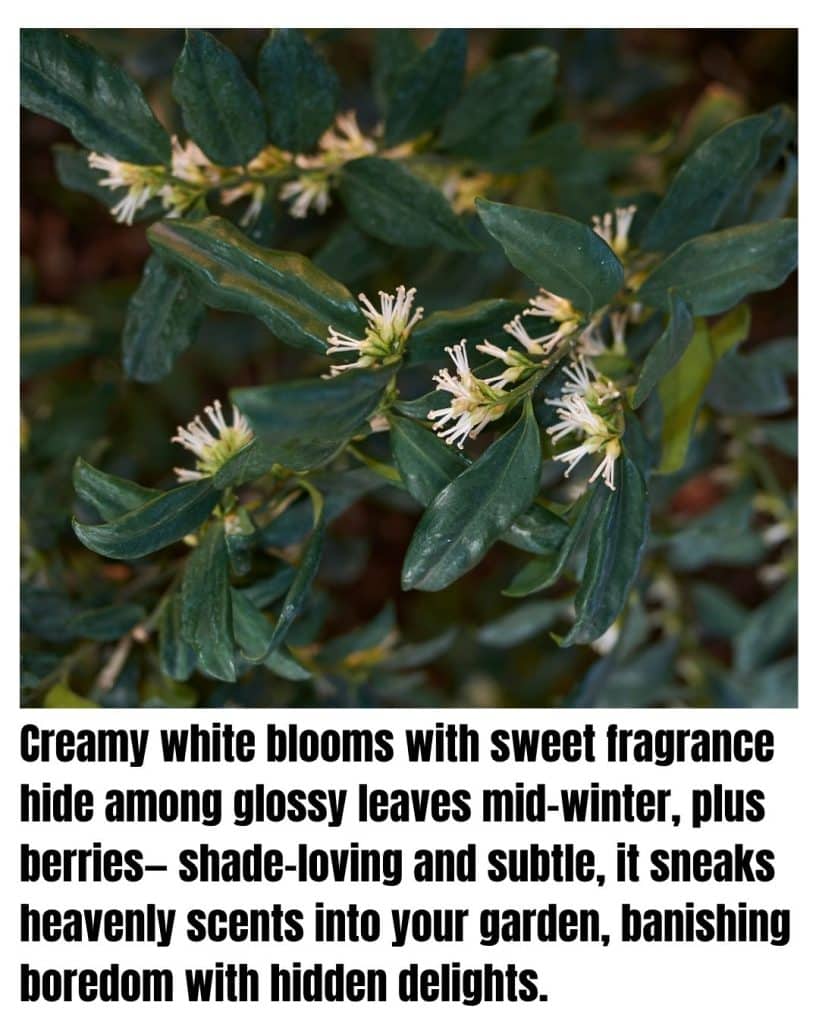
- Special Trait: Tiny, hidden flowers pack a vanilla-honey punch, followed by glossy black or red berries for subtle, multi-season charm.
- Interesting Fact: Shade superstar—thrives in deep darkness where others fail, making it the ultimate underdog bloomer.
- Where It Grows: USDA zones 6-9, from humid Southeast to mild West, in dry shade with average, well-drained soil.
Sarcococca sneaks sweetness into winter with creamy blooms from December to March, their fragrance sneaking up like a delightful secret.
This evergreen shrub spreads slowly to 3 feet, forming dense groundcover under trees. In southern US, it’s heat-tolerant; northern edges need protection. Plant in forgotten shady corners—it tolerates neglect beautifully.
Pollinator-friendly and deer-resistant, its berries attract birds. Imagine inhaling heavenly scents from unassuming foliage, as it quietly conquers dim spots, infusing your winter landscape with hidden treasures and effortless allure.
So there you have it—17 unstoppable winter warriors ready to transform your frosty yard from drab wasteland to vibrant wonderland.
Whether you’re battling blizzards in the North or mild chills down South, these blooms prove that color doesn’t hibernate.
Grab your trowel, plant a few this fall, and let Mother Nature’s rebels do the rest. Your garden (and your Instagram) will thank you—because who needs spring when winter’s this fabulous?